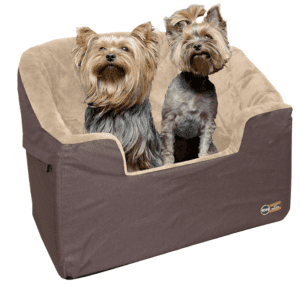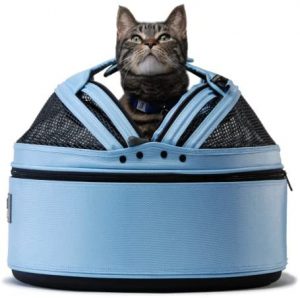Travel with Dogs: Restraints, Rules and Regulations
14 September 2024
In Australia, we love our active lifestyle and don’t think twice about piling the whole family, including our dogs, into the car for a trip to Bunnings or even to the beach!
But unfortunately, many of us also don’t think twice about the safety of our dogs in the car and the risks associated with going for a drive with our dogs.
Being animal lovers (and insurance specialists), our Petcover staff often bring their pets to work in the car. We strive to keep our dog safe in the car, so all staff follow Petcover’s Safe Pet Travel guidelines. Now we want the same for your pets. Safe travel is important to us.
Perhaps it’s time to consider if your best friend needs a seatbelt too
Do you like to road trip with your dog? Are you already in the habit of restraining your dog in the car?
Across Australia and New Zealand, the laws and regulations surrounding pets in vehicles vary, with NSW having the strictest laws; however, most Australian states legally require dogs to be restrained in the back of a car. Failure to comply with these rules can result in a fine, loss of demerit points, or worse.
It’s commonly reported that each year in Australia, 5,000 dogs are sadly injured or lose their lives due to being unrestrained in a motor vehicle.
How do you keep your dog safe in a car?
When thinking about your pet’s car safety, it’s essential to consider your dog and other passengers of the car. Keeping an animal safe in the car isn’t just about making sure your dog isn’t hurt in an accident but, travelling with pets in the vehicle also means we need to ensure your dog isn’t a distraction to the driver.
The simplest thing you can do to keep your dog safe in the car is to keep them restrained and follow our simple Safe Pet Travel Guidelines.
Petcover’s Safe Pet Travel Guidelines
Petcover’s staff adhere to the following guidelines when bringing their dog or cat to work:
1. The driver must not drive with their pet on their lap
Do not let your dog travel on your lap while you are driving. Your dog can be a distraction to your driving, but it could also get in the way of your ability to drive correctly and safely.
According to Sergeant Marty Arnold, Officer in Charge Road Policing Unit Bundaberg:
“It is not uncommon to see dogs not only sitting on the driver’s lap but from time to time standing upright resting their front paws on either the steering wheel or driver’s side window. We have even had cases where the pet had jumped down into the driver’s footwell area, making it difficult for the driver to brake. This can be dangerous for several reasons. A pet standing or sitting on a drivers lap could interfere with the driver’s ability to steer, indicate or even obscure the drivers view.”
2. Pets must not be on the front seat
Do not let your dog travel on the front seat of your car. As with letting your dog sit on the driver’s lap, even having a dog on the front seat can be a huge distraction, further to this Sergeant Arnold says:
“It is also dangerous for the pet should a vehicle be involved in a collision. Your pet would likely be injured if thrown around the cabin of your vehicle or injured by a deploying airbag.“
3. Pets must be secured in the back of a car using an appropriate restraint
Secure your dog on the back seat using a dog-friendly, approved restraint. These car restraints for dogs can be purchased online or at your local pet store.
What should you consider when purchasing a dog restraint for the car?
There are many pet restraints on the market, ranging from harness style restraints to dog booster seats while cats for instance, generally cope better with car travel when secured inside a small cage/crate. According to Bone & Yarn, the following are important points to note when shopping for a dog restrain to use in the car:
Size: Like infant restraints, dog restraints are also weight rated. It’s important to ensure that the type of restraint you choose matches the size of your pet.
Method of securing: Make sure your car is compatible with the dog restraint or car seat. Does it click into the existing seatbelt? Does it need a headrest to secure it correctly? Does the restraint need to be used in conjunction with a lap-sash seatbelt?
Ease of use: Consider how easy the restraint is to use. Ask yourself if you need a multi-purpose restraint. Can your dog’s walking harness double as a car restraint? If you have a smaller dog, is a combined dog carrier/restraint the right choice for your needs? Perhaps your dog isn’t a fan of the car and is best positioned so they can’t see out the window, or maybe your dog just HAS to have a good view and needs a booster seat?
Type of dog restraints available
Once you have decided the size, how you’re going to secure the restraint and how you’re planning to use it, next you can consider what type of restraint is best. Does your dog need a booster seat, a harness, or would your beloved dog travel better in an enclosed carrier/restraint. Below are some examples of dog restraints that Bone & Yarn have reviewed.
The Bucket Booster pet seat
The Snoozer Lookout car seat
The WOpet Car Seat Carrier
The Sleepypod Mobile pet bed
The Sleepypod ClickIt Sport Harness
Further recommended reading
Rules and regulations for car travel with your dog
Animal Welfare Victoria – Travelling with dogs
Prevention of Cruelty to Animals Act 1979 – As of 17 February 2021
Is it illegal to drive with a pet in Australia?




